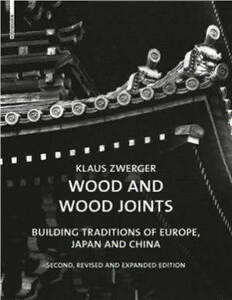
Wood and Wood Joints: Building Traditions of Europe, Japan and China PDF
Preview Wood and Wood Joints: Building Traditions of Europe, Japan and China
Zwerger_Holzverb_Inhalt-dt_en.qxd:Holz-deutsch 11.3.2011 9:52 Uhr Seite 1 Wood andWoodJoints Zwerger_Holzverb_Inhalt-dt_en.qxd:Holz-deutsch 11.3.2011 9:52 Uhr Seite 2 Zwerger_Holzverb_Inhalt-dt_en.qxd:Holz-deutsch 24.3.2011 15:03 Uhr Seite 3 KlausZwerger Wood and Wood Joints BuildingTraditionsofEurope,JapanandChina WithaForewordbyValerioOlgiati Second,RevisedandEnlargedEdition Birkhäuser Basel Zwerger_Holzverb_Inhalt-dt_en.qxd:Holz-deutsch 16.3.2011 8:20 Uhr Seite 4 TranslationintoEnglish: Allphotographsarebytheauthor,unlessotherwise GerdH.Söffker,Hannover noted. PhilipThrift,Hannover TranslationofForeword,Structural TimberConstructioninChinaand Thisworkissubjecttocopyright.Allrightsarereserved, additionstoIntroductionand whetherthewholeorpartofthematerialisconcerned, Appendix:JulianReisenberger,Weimar specificallytherightsoftranslation,reprinting,re-useof illustrations,recitation,broadcasting,reproductionon Graphicdesignofthefirstedition: microfilmsorinotherways,andstorageindatabases.For AtelierFischer,Berlin anykindofuse,permissionofthecopyrightownermust beobtained. Graphicdesign,coverandproduction: ActarBirkhäuserPro ThisbookisalsoavailableinaGermanlanguageedition www.actarbirkhauserpro.com (ISBN978-3-0346-0684-4). Barcelona-Basel ©2011BirkhäuserGmbH,Basel ACIPcataloguerecordforthisbookis P.O.Box,4002Basel,Switzerland availablefromtheLibraryofCongress, PartofActarBirkhäuser WashingtonD.C.,USA. Printedonacid-freepaperproducedfromchlorine-free Bibliographicinformationpublishedby pulp.TCF∞ theGermanNationalLibrary PrintedinGermany TheGermanNationalLibraryliststhis ISBN978-3-0346-0685-1 publicationintheDeutsche 987654321 Nationalbibliografie;detailed www.birkhauser.com bibliographicdataareavailableonthe Internetathttp://dnb.d-nb.de Distribution: ActarBirkhäuserD Barcelona–Basel–NewYork www.actarbirkhauser.com RocaiBattle2 E-08023Barcelona T+34934174993 F+34934186707 [email protected] Viaduktstrasse42 CH-4051Basel T+41615689800 F+41615689899 [email protected] 151GrandStreet,5thfloor NewYork,NY10013,USA T+12129662207 F+12129662214 [email protected] Zwerger_Holzverb_Inhalt-dt_en.qxd:Holz-deutsch 16.3.2011 8:20 Uhr Seite 5 Contents ForewordbyValerioOlgiati 6 Introduction 7 TheMaterial ThePropertiesofWood 10 SpeciesofWood 32 WorkingwithWood Uses 42 TheCarpenter 54 TheCarpenter’sTools 67 FormsofConstruction 78 TypesandFunctionsofWoodJoints Typology 85 ClassificationSystemsintheLiterature 91 LimitstotheClassificationSystems 97 TheFunctionsofWoodJoints 100 WoodJointsandTheirEvolution TheRoleoftheTool 112 BuildingTasksandTheirSolutions 132 LogConstruction 140 Column-and-BeamConstruction 153 RoofConstruction 176 TheInfluenceofClimaticConditions 211 AbundanceandScarcetyofTimber 226 WoodJointsasanExpression ofAestheticValues TheVisibleandtheInvisible 247 ProtectionandPrestige 253 ConstructionandDecoration 258 StructuralTimberConstructioninChina BuildingMethods:LogConstructionand Column-and-BeamConstruction 268 StructuralWoodPreservation:RaisedPlatformandCantileveredRoof 275 ChoiceofMaterials 278 TheStructureandConstructionofTempleBuildings 279 TheConstructionPrinciplesofBracketComplexes 289 Dougong 290 TheEconomicsofConstruction 297 Bibliography 306 Acknowledgements 311 IndexofPersonsandBuildings 312 IndexofPlaces 313 SubjectIndex 314 Zwerger_Holzverb_Inhalt-dt_en.qxd:Holz-deutsch 24.3.2011 14:15 Uhr Seite 6 Foreword Aftersearchingforacopyofthisbookandintheknowledgethat the English version was already out of print, we contacted the authorandthepublisherdirectly.Notonlywereweluckyenough toreceiveoneofthelastremainingcopiesbutalsolearnedthata neweditionwasinpreparation.Thisisnowavailableandweare delightedthatthiswonderfulbookcanonceagainfascinatenew readers. Illustratedwithbeautifulphotographsandmeticulousdrawings, thebookdetailsthelongtraditionanddevelopmentoftimbercon- structioninEuropeandAsia.Architectsandcarpenterscultivateda highlydevelopedunderstandingofthismaterialandthepossibili- tiesitoffered.Thepathofforcesandthespecificpropertiesofthe material fundamentally determined the formal appearance of timberconstructionsandtheirdetails. Timber construction has always related closely to the engineer’s way of working and, compared with load-bearing construction, wasveryhighlydeveloped. Thecultureofbuildingwithwood,itstradition,itsregionalandcli- matic particularities, its influences and developments are docu- mentedinimpressivedetailinthisbook. Inthelastfewcenturies,buildingwithwoodhaschangeddramatic- ally.Adhesivesandsteelcomponentshavechangedthecharacter ofitsconstruction.Incontemporaryarchitecture,woodisusedfor surface cladding or in construction in the form of resin-soaked materialssuchaschipboardorsandwichpanels.Knowledgeand skillsofthekinddescribedinthisbookarerarelyseentoday. Myownbuildingsfromthepastfewyearshavebeenmadeprimar- ilyofconcrete.Withconcreteonecanbuildhousesthataremade almost entirelyofasinglematerial.Reinforcedconcretecansus- taintensileandcompressiveforces,canbeusedasaslaborabar andcanbeassembledonsiteinphases;themanifestationofan ideatoformalargerwhole. Allthisispossiblewithwoodaswell.Itisjust thatwenolonger knowwhatthismaterialiscapableofandlacktheskillstoworkit. Andthatissomethingwecanchange. Inthisrespect,thisbookisawelcomeinspiration. ValerioOlgiati Flims,December2010 6 Zwerger_Holzverb_Inhalt-dt_en.qxd:Holz-deutsch 16.3.2011 8:22 Uhr Seite 7 IntroductiontotheSecondEdition Therearetwoquestionswhichcouldberegardedasathreadlink- ingthevarioussectionsofthisbook.Firstly:“Whatwerethecon- ditions which governed the development and form of timber connections?”And secondly:“Can the timber connections of Eu- ropeandJapanbecompared?”Bothquestionsareinterdependent; thesecondcannotbeansweredwithoutadetailedconsideration ofthefirst. Ifalltheessentialfactorswhichhavecontributedtotheformation of a timber connection are elucidated,i.e.the material itself,the personworkingthematerialandtheproducttherebycreated,then wecometotheconclusionthatajuxtapositionofthesetwocul- turesoftimberconstructionisindeedpossiblebutthatabalanced comparisonoftheachievementsmustberegardedasproblematic, ifwecancountenancesuchathingatall. To the sensitive observer, wood joints often allow the train of thought of theircreator tobefollowed.(Thecarpenterproduced the joint;from its form we can deduce what he thought in each case!) The creator’s design considerations have taken on a form whichwetodayinterpretasareflectionofwhatwasonceacknow- ledgedasgood.Ontheotherhand,thecareshownintheexecu- tion, thereadiness toproducecomplexjoints,hasnot alwaysre- mainedthesame. This book describes and explains joints made exclusively from wood, i.e. without adhesives and without metal connectors, to- getherwiththeiroriginsandevolution.Todothis,Ihavestudied theexamplesfoundtoday,examinedthescientificliteratureavail- ableand,whereinformationwaslacking,carefullysupplemented thisinorder tofillin thegaps.Particularattentionispaid to the materialaswellastoclimatic,technical,woodworkingandartistic influences.Itmightappearproblematicthatindoingsotheorigins ofcertaintypesofjointsarediscussedinthecontextofveryspe- cific causes.If,for example,the development of splicing joints is dealtwithinthechaptercoveringdependencyontheoccurrence ofwood,thenthisshouldnotbetakenasbeingmoreimportant thananyotherfactorinthecreationofsuchjoints;likewisethein- fluenceofclimaticconditionsforthedescriptionofboardjointing. Thereaderisreferredtotheselectivenatureoftheexamplesgiven in the chapter on the relationship between timber connections andbuildingtasks. Theclassificationemployedin thechapteron the typesofwood joints,whichthereadermightfeelisinsufficientlydifferentiated,is intendedtoreflecttheconsiderationgiventothespecificmaterial properties –oncedecisiveininfluencingtheconstruction.Thechar- acteristicsofwood,notwopiecesofwhichareeveridentical,have certainlynotbeenaccordedadequateattentionbyeverycarpenter inthepast,but,inevitably,toamuchgreaterextentthanisthecase today.Aslongasitwasusedinitsnaturalform –andthatisthe themeofthisbook –,thecomplexityofthematerialwasaccepted forwhatitwas.Fortoday’stheoreticalapproachthismeansthat any classification, if it is to achieve a more detailed distinction, musteithersetartificiallimitsandexcludephenomena,orleadto perpetualrepetitions.Onthewhole,theinfluencesdescribedhere whichhelpedshapejointsinEuropeandJapanwereabletoberead- ilycompared,atleastinthisselection.Inordertomakethisclear, theaimhasbeentotrytoplaceaJapaneseequivalentalongside 7 Zwerger_Holzverb_Inhalt-dt_en.qxd:Holz-deutsch 16.3.2011 8:22 Uhr Seite 8 everyexamplechosenfromEurope.This,atthestartperhapscon- fusing,methodwastheonlysolution,whenseeninthelightofthe enormouswealthofmaterial,tomakingtheintendedcomparison easilycomprehensibleonourjourneythroughthousandsofyears oftimberarchitecture. The reader will notice that many dates remain vague or are not evenhintedat.Thereisagoodreasonforthis.Thedateofthecom- pletion of a building can be ascertained.The evolution of a con- structionform,e.g.thesparroof,cannowbetracedbackfurther andfurtherthankstomoreintensiveresearchworkinrecentyears. Nevertheless,therestillremainsthefactthattheremayhavebeen other,evenearlierexampleswhichhaveinthemeantimebeendes- troyedandwhichwillalwaysremainanunknownvariable.Looked atinthiswayitisperhapseasytounderstandwhytheregularlist- ingofdateshasnotevenbeenconsidered. AwordortwoabouttheconstantlyrecurringJapanesetermsisne- cessary.Generally,nocapitallettersareemployedunlesstheword isapropername.Thenamesofpeoplearereproducedinthetradi- tionalJapaneseform,i.e.thesurnamebeforetheforename.Tem- plesorshrinesareculturalcentresofBuddhismorShintoism.AJa- panesepersoncandeducefromthenameTodai-jithattheobject inquestionisaji,i.e.atemple.However,inadditiontojitherearea numberofotherJapanese termswhichallmean templeandyet othersforshrine,jinja,forinstance.Inordertoavoidtautological constructionslike“TodaiTempleTemple”,inthecaseofaconflict wehavedecidednottodistinguishbetweenshrineandtemplefor the reader from other cultures.The difference can be recognized fromvariousdetailsonoraroundthestructure,anditisirrelevant for the wood joints presented in this book.Those who travel to Japanwillquicklydiscoverthe,evenforvisitorsfromtheWest,im- mediatelyrecognizabledistinguishingfeatures. OfallthemanymessagesIreceivedinresponsetothefirstedition ofthisbookin1997,notonetookissuewiththefactthatEurope andJapanwereratherunequalpartnerstocomparewithonean- other.Formyself,however,thisaspectbecameamatterofincreas- ingconcern.Sowhenthepublisherapproachedmewiththeinten- tionofbringingoutanewedition,Ifeltcompelledtoputthisright andexpressedthewishtoaddachapteronhistoricaltimbercon- structioninChina. Therearemanyfascinatinglinesofdevelopmentintimberarchi- tecture,butifaskedtonamethemostadvancedculturesofbuild- ingwithwoodIwould,without hesitation,choose theEuropean andEastAsian.IhaveconsciouslyavoidedspeakingofWesternor FarEasternbuildingtraditions.Theterm“FarEast”reflectsaeuro- centricstandpointthatrefersbacktotheeraofEuropeanImperia- lism.IntheBritishEmpire,theterm“FarEast”servedtodividethe AsiancontinentfromtheterritoriesoftheNearandMiddleEast. TodaywespeakofSouthAsian,SoutheastAsian,andEastAsianre- gions.Thevarietyof timberconstructionsinSoutheast Asiamir- rorstoacertainextentitsgeography.Onecantracereciprocalin- fluencesbetweenthedevelopmentsinSoutheastAsiaandthose inEastAsia.Intheborderregioninparticular,itisoftennotpos- sibletoclearlyidentifythelocalarchitectureasspecificallySouth- eastAsianorEastAsian. Nevertheless,whenonefollowsthehistoricaldevelopments,itis possibletotraceveryclearlythedevelopmentsofChinesetimber construction. For them, the ruling periods of foreign dynasties 8 Zwerger_Holzverb_Inhalt-dt_en.qxd:Holz-deutsch 24.3.2011 15:08 Uhr Seite 9 were not seen as a break but,on the contrary,as an enrichment (Liao,Yuan)and–dependingonone’sviewpoint–anendpointora culmination (Qing).The Japanese building culture, as previously mentioned,owesitsdevelopmenttoanotinconsiderabledegree to examples and techniques imported from elsewhere, such as Korea,butaboveallfromthevastChineseEmpire. In the new chapter I have again followed the principle of a colourfulmixtureofvernacularbuildingsandso-calledhigharchi- tecture.Therearetwomainreasonsforthis.Thefirstisthattheor- ganisationofthebookisbasedoncriteriathathavenothingtodo withthisdistinction.Thesecondcanbeattributedtoafirmbelief thatsingularexamplesofhigharchitecture“mustbeseeninrela- tionto,andinthecontextof,thevernacularmatrix,andareinfact incomprehensibleoutsidethatcontext,especiallyasitexistedat thetimetheyweredesignedandbuilt”.1Thatsaid,thisviewpoint shouldinnowaycallintoquestionthefactthatawholeseriesof constructional phenomena in vernacular architecture are drawn fromexamplesofhigharchitecture.Idonot,however,subscribeto thegeneralopinionthatdevelopmentsinelitearchitecture,where theyaresometimesdescribedasbeingcharacteristicofarchitec- tural styles,gradually diffuse into vernacular architecture where theythenreappearasimitations. HadIwishedtofollowthesameprincipleofdirectcomparisonbe- tweenEuropeanandJapanesebuildingtechnologyfortheChinese examplestoo,Iwouldhavehadtorewritetheentirebook.Thiswas neither in the interest of the publisher nor in mine.I decided in- steadtoappendthechapteronChinesearchitectureasaself-con- tainedchapter.Thereaderwillhavenodifficultyincomparingthe examplesshownwiththosefromJapanorthosefromEurope.That is not least thanks to the critical and sensitive work of Andreas Müller,whowastheeditorinchargeofboththefirsteditionand thisexpandededition. AmosRapoportwasoftheopinionthatbuildingscanbeexamined in a variety of different ways:“One can look at them chronolog- ically, tracing the development over time either of techniques, forms,and ideas,or of the thoughts of the designer,or one can studythemfromaspecificpointofview.”2ThecomparisonofEu- ropeandJapanmixesbothapproaches,asdoesthestudyofbuild- ings in China,albeit taking a rather different viewpoint.This ap- proachcreatesaformalconnectionbetweentheexistingsection– whichhasbeencheckedandslightlychanged,withsomenewpho- tographs–andthenewchapter.Withthisadditiononecannowle- gitimatelyspeakofacomparisonofthedevelopmentsinEurope andEastAsia. 1Rapoport,1980,p.284 2Rapoport,1969,p.15 9 Zwerger_Holzverb_Inhalt-dt_en.qxd:Holz-deutsch 11.3.2011 9:52 Uhr Seite 10 TheMaterial Thepropertiesofwood “Byapplyingappropriatetoolsandtechniquestoagoodpiece of timber,a woodworker’s imagination is limited only by the natureofhismaterial–amaterialthatoftenseemstohavea lifeofitsown.”1 Every material is distinguished by characteristics peculiar to itself.Knowledge of these is a necessary prerequisite for pro- cessing the material appropriately.Wood lets us know quite definitely and unpleasantly when it is not being treated cor- rectly, whether due to negligence or lack of knowledge. But woodalsoobstructsuswhenwetrytounravelitsmechanical, physicalandchemicalproperties.Manymoderntextbooksat- tempttopresentthematerialinawaywhichjustifiesthistheo- reticalapproachtoitsuse.Twistedfibres,bowsandcolourdis- crepanciesareonlyreferredto,ifatall,asabnormalitiestobe cutout;beauty,asanon-technicalterm,isanunknownword. All the properties of wood are interlinked.They interact with eachotheroraredependentoneachotherinsuchawaythat 1 Thejointsofthediagonalbracing thistextbook-typeofclassificationisquitesimplyinadequate membersonthisbridgebetweenAppen- ifwewishtoexplaintheconnectionbetweenthecharacteris- zellandSchlattinSwitzerlandareso tightlyrestrainedthatsettlementatthe ticsofwoodandthecultureofwoodworking. cornerintheleftforegroundhascaused The loading capacities of timber in tension (Fig. 1) and com- thewoodtosplit. pression(Figs2&3),inbending(Fig.4)andshear,i.e.theme- chanicalproperties,needtobeconsidereddirectlyandvisually, as apprentices once did on their long way to becoming mas- ters.Thepracticalreappraisalofwhathadbeenseeninactive workanddailyroutinewasinanycaseonlyachievedcompe- tentlybyveryfew.Thesizeofthecross-sectionisoffundamen- talsignificancefortheloadingcapacity.Theoversizedmembers oftenencounteredinolderelements,possiblynotunaffectedby considerationsofproportion,i.e.partlydeterminedbyaesthe- tics, undeniably contributed to the preservation of the ma- terial.Otherauthorsdisputesuchoversizingandprove“thatthe timber constructions investigated from the period between 1000and1800areoftenloadedtothelimitoftheircapacity.”2 According to David Gilly in 1797:“For example, the machine master Reuss from Dresden cut the heavy truss posts in the town’soperahousetosuitthemachineryinsuchawaythata narrowopeningwascreatedthroughbothtrussposts.Hewas verywellawarethatthetrusspostswouldremaincapableof takinganyloadlikelytobeputonthem.”3Examplesofoversiz- ing are the (sometimes) original columns of Norway’s stave churches,4Switzerland’swoodenbridges,whicharecapableof carrying today’s heavy road traffic,5 or Japanese temples and shrines.ThefireintheHoryu-jiin1949canberegardedasan exampleofjustwhatstresseswoodcanwithstandevenafter 1200years.Thecolossaldimensionsofthecolumns,each1.5m in diameter,are certainly to thank for the fact that sufficient 2 Intechnicaltermstheloading undamaged timber remained to guarantee the survival of a capacityparalleltothegrainis largepartofthestructureintact.6Intotalcontrasttothisare greatest.However,inastructure,as thesometimes“stupidityprescribedstandardizedsizesforall compressiveforcesincreasesodoes thesusceptibilitytobuckling.– postswhichwouldhavebeenheavierinplacesiftheconstruc- CowshedonafarminZaunhof,Tyrol, tionhadbeenlogicallyworkedout.”7 Austria. 10
